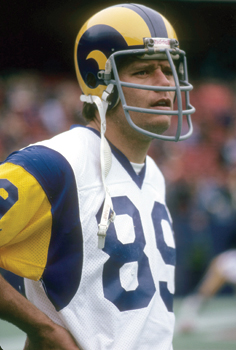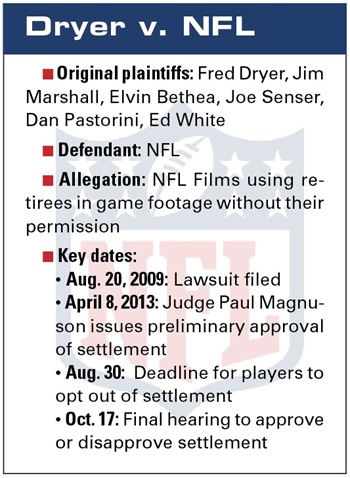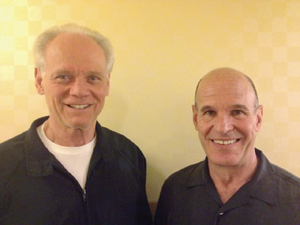NFL retirees face an Aug. 30 deadline to opt out of a $50 million image lawsuit settlement with the NFL, a deal the league, high-powered class-action law firms, and high-profile ex-players like Jim Brown support. Even the federal judge overseeing the case blessed the settlement and belittled the opposition in his April ruling on the matter.
So why then do the initial six plaintiffs, who filed the lawsuit exactly four years ago Tuesday, vehemently oppose settling? Fred Dryer, one of those six whose name adorns the lawsuit that contends the league owes retirees for use of their images in NFL Films, calls the preliminary settlement the latest example of the league “pummeling” retirees and a “disgrace and a heartbreak.”
 |
“I stopped making [an NFL] salary in 1981,” said Dryer, shown in 1978, “but I have been working for them ever since.”
Photo by: GETTY IMAGES
|
“I was called by [lawyer Bob Stein] to put this together with the intention of helping to solve this problem, to make a demand to the league to stop using our rights,” said Dryer, who played in the NFL for 13 years and has since been an actor, starring in the 1980s TV crime drama “Hunter.” “I stopped making [an NFL] salary in 1981, but I have been working for them ever since and I am kind of tired [of] it. I want to be paid for it.”
Dryer, his former teammate Stein and their brethren are trying to get as many retirees as possible to opt out by the Aug. 30 deadline or to oppose the settlement at an Oct. 17 hearing in Minnesota federal court that would make the settlement final. They contend the settlement makes their situation worse by granting the NFL unlimited rights to use them in NFL Films without compensation.
The stakes are high for the NFL, too. The 100th anniversary of the league and the 50th Super Bowl are approaching (in 2019 and 2016, respectively), and use of historical footage is a key part of the celebration. The league also continues to carry bad publicity surrounding its treatment of retirees from the ongoing class-action concussion case. It clearly wishes to settle allegations it is not paying retirees for their commercial use.
The settlement as it stands would pay $6 million to the law firms involved in the litigation and $42 million to charities for retirees. (That latter amount could fall below $30 million if a projected maximum amount of $13 million additionally is spent to cover legal fees in fighting future lawsuits from players who opt out of the settlement.) The remaining settlement cash funds a new licensing agency, run by IMG, that depending on which side you ask is either a revolutionary effort to represent retirees in the market or a red herring designed to distract players from the fact the NFL is stealing their images (see related story).
 |
The retirees who support the settlement point to the decision from Judge Paul Magnuson in his preliminary approval of the deal, when he wrote, “It is unlikely that any single plaintiff’s case is so valuable as to warrant engaging in the protracted litigation that is likely to follow if this case is not resolved. The merits of the case weigh very heavily in favor of the settlement.”
The Pro Football Retired Players Association, the retirees group created by the proposed settlement, quoted Magnuson in a letter last month to retirees arguing why they should approve the settlement.
Retirees have three options at present: support the settlement, for which no action is necessary; opt out, which means the settlement would not cover them; or stay in and oppose, but in which case they would still be covered by any settlement.
Stein, who debated league lawyer Gary Gertzog on the matter in front of retirees at the Pro Football Hall of Fame earlier this month, does not disagree that on their own, retiree images are not worth much. As part of the NFL Network and NFL Films, Stein argued, the images are worth plenty.
Why then is there a suggested settlement if the original plaintiffs are opposed?
According to Dryer, the case was hijacked by the law firms brought on board.
Stein, whose background also includes being the first president of the Minnesota Timberwolves, in 2009 reactivated his law license, which had been dormant for 22 years, after a former teammate approached him in 2008 asking about his use in NFL Films. Without class-action experience, Stein approached and hired the two lead law firms — Zimmerman Reed and Hausfeld LLP — groups in which he now says he misplaced his trust.
 |
Fred Dryer and Bob Stein
Photo by: SWEENEY VESTY
|
“I associated with some people who I thought wanted to do the right things for retired players,” Stein said.
Said Dryer, “We hired people to represent our interests, and they didn’t.”
The board of players that’s been created to oversee the licensing agency, along with the judge, say it’s not that the case has been “hijacked,” the term Dryer uses, but that experienced class-action firms recognize this is the best settlement that can be had for former players. NFL spokesman Brian McCarthy said of the notion that the settlement is unfair, “We disagree and so did the judge. We look forward to building an unprecedented new relationship with retired players that will benefit everybody, especially those who need extra medical or financial assistance.”
Ted Frank, who runs the Center for Class Action Fairness, said the situation does raise questions about lawyers and their rights to clients. The center is a public interest law firm that represents consumers and shareholders in objecting to what its deems bad class-action settlements. Plaintiffs, Frank said, should get the final call.
“A class action is run by the plaintiffs, and the judge and the law firms seem to be acting like it is run by the law firms,” he said of the Dryer case. “There is a very good chance that this gets overturned on appeal.”
If Magnuson does proceed to approve the settlement, the retirees opposing the settlement can appeal the case to the 8th U.S. Circuit Court of Appeals.






